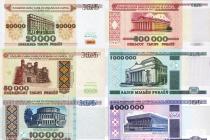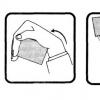First lesson.
Goals and objectives of the lesson: To deepen the idea of groups of words with a common meaning as parts of speech with the introduction of their terms: noun, adjective, verb.
Learn to guess and compose texts of riddles about cabbage. Basic concepts: parts of speech, noun, adjective, verb.
Dictionary words: TO a empty.
During the classes:
- Exercise 1 page 72. Exercise in the ability to group words as parts of speech.
Find the "extra" word in each line.
Gladiolus, carrot, violet, rose.
Gladiolus, violet, red, cabbage.
Walks, jumps, swims, run.
direct, cheerful is reading, interesting.
Write out words that name: 1) objects; 2) signs of objects; 3) actions of objects.
- Working with the rule on page 72. Introduction of the term part of speech.
In the science of language (grammar), groups of words with a common meaning are called parts of speech.
III. Ex. 2 p. 72. Orally. Deepening ideas about groups of words with a common meaning as parts of speech with the introduction of their terms: noun, adjective, verb.
Look at the table.
What can you learn about word groups from it?
Words are parts of speech
IV. Ex. 4 p. 73. Identification of common and different parts of speech.
Write down the words, distributing them into parts of speech.
Pen, writes, beautiful, loud, whistles, September, album, will draw, black, chamomile, studies, careful, student, high, will read.
Underline the unstressed vowels in the vocabulary words.
v. Ex. 5 p. 73. Consolidation of ideas about groups of words with a common meaning as parts of speech. Repetition of terms: noun, adjective, verb. Drawing up proposals for the proposed schemes.
What proposals can be made according to such schemes?
Write down the sentences.
| Existing, ch. ?
| Adj. noun, ch..
| preposition existent, ch. noun!
VI. Work with vocabulary words cabbage, cabbage. Learning to guess and compose texts of riddles about cabbage.
Not sewn, not cut,
And all in scars;
Without counting clothes
And all without zippers.
(Cabbage)
The lady sat down in the garden,
Dressed in noisy silks.
We are preparing tubs for her
And half a bag of coarse salt.
(Cabbage)
How I put on a hundred shirts,
Crunched on the teeth.
(Cabbage)
- An exercise in the use of parts of speech with different lexical meanings.
What nouns are used in the couplet?
Is it one word or two different ones?
Who is the arrow from the bow
Shot through the head of an onion?
VIII. Summary of the lesson.
What questions do nouns answer?
Give examples.
What questions do adjectives answer?
Give examples.
What questions do verbs answer?
Give examples.
IX. D / z: Ex. 3 p. 73.
Complete the sentences with nouns with a generalized lexical meaning.
What is the common meaning of all the inserted words?
Insert the missing letters. Explain their spelling.
Maple, ... sina, b .. cut - ... .
Beets, ..cucumber, k..empty - ... .
Rose, r..masha, peony - ... .
At home, write down sentences by inserting letters and completing sentences with nouns with a generalized lexical meaning. Underline the inserted letters.
Lesson topic: Groups of words with a common meaning. Second lesson.
Goals and objectives of the lesson: To deepen the idea of groups of words with a common meaning as parts of speech with the introduction of their terms: noun, adjective, verb.
Exercise along the way in the use of parts of speech with different lexical meanings.
Learn to guess and compose texts of riddles about cabbage. Basic concepts: parts of speech, noun, adjective, verb.
Dictionary words: K a empty, m O rkov, O range.
During the classes:
Grouping words as parts of speech.
Identify common and different parts of speech
Find key words-signs of the answer in the text of the riddle.
What actions and qualities does the poet E. Serova attribute to the bells? Read.
Bell blue
He bowed to you and me.
- Bellflowers
Very polite... And you?
Sleep. Indicate familiar parts of speech in abbreviated form: noun, adj., ch. Underline the words used figuratively.
Read the riddle. What lady are you imagining?
The lady sat down in the garden,
Dressed in noisy silks.
We are preparing tubs for her
And half a bag of coarse salt.
Write down the riddle and the answer. Point out the verbs.
Choose an antonym for the verb dressed.
Make sentences from words. Write them down.
Fluffy, snow, fell out.
Dress, dressed up, in, white, earth.
Large, swept, snowdrifts.
carrot, carrot, orange
What parts of speech are these sentences made of? Write abbreviated parts of speech above the words.
Write the text, inserting suitable words instead of questions: orange, carrot, riddle, color, vision, green, eat.
You all know (what?) about the red girl who has (what?) a braid on the street. (What?) - a favorite vegetable of the peoples of different countries. In (what?) Its color (what does it do?) The substance "carotene". When you (what?) a carrot, this substance will turn into vitamin A, which improves (what?) and helps to grow.
Indicate the parts of speech above the inserted words.
Notice! Specific (lexical) meanings of words are studied by vocabulary, and general (grammatical) meanings and forms of words are studied by grammar. Vocabulary and grammar are sections of the science of language.
What words does the poet use in the rhyme?
A fox walked along the path And carried mushrooms in a basket: Five honey mushrooms and five chanterelles For the cubs and for the chanterelles.
(I. Maznin)
Write down the rhyme.
Underline the multi-valued nouns.
Why are mushrooms so named?
Point out the verbs.
What question are they answering?
Which word in the text answers the question how much!
Lesson topic: If you are polite ... Polite words
Goals and objectives of the lesson: Give an idea of another group of (interjection) words with the common name "polite" words.
To systematize the knowledge that children have about the rules (words, gestures) of etiquette in situations of greeting, farewell, request, gratitude. To form the skill of using different etiquette language formulas in accordance with the situation.
Basic concepts: Greeting, farewell, request, gratitude.
Dictionary words: cn a sibo, p O sting ys that
During the classes:
I. Acquaintance with a group of interjectional words with the everyday name "polite" words.
1. Exercise 1 p.76. Examples of the use of "polite" words in proverbs. Recording proverbs from memory.
What does the people teach in proverbs?
Nothing is expensive, knowledge is expensive*.
An affectionate word that the sun.
Write down the second proverb from memory.
In what situations can it be used in speech?
2. Exerc. 2 p.76. Formation of the skill of using different etiquette language formulas in accordance with the situation. Working with vocabulary words a sibo, p O sting ys that
What courtesy words do you already know?
In what situations do you use them?
Learn how to write these words correctly.
3. Exerc. 3 page 76. Systematization of the knowledge that children have about the rules (words, gestures) of etiquette in situations of greeting, farewell, request, gratitude.
Why are polite words called kind, magical?
Remember when a kind word helped you.
4. Exerc. 4 p.76. Systematization of the knowledge that children have about the rules (words, gestures) of etiquette in situations of greeting, farewell, request, gratitude. Selective write-off.
Read an excerpt from V. Oseeva's story.
What magic word is it dedicated to?
Pavlik approached his sister. Looking into her eyes, the boy said in a low voice: "Lena, give me one paint, please." Lena opened her eyes wide and muttered in embarrassment: “What do you want?”
Write down Pavlik's request.
5. Exerc. 5 p.76. Rationale for the choice of etiquette language formulas in accordance with the situation.
How do you complete sentences?
Write them down.
Hello, dear (th) ...! Goodbye, ... !
6. Exerc. 6 p.77. Rationale for the choice of etiquette language formulas in accordance with the situation. Writing off offers.
What words can be used to greet a friend?
And what kind of farewell?
Write them down.
7. Exerc. 7 p.77. Formation of the skill of using different etiquette language formulas in accordance with the situation. Selective write-off.
Write the sentences from the letter, inserting the necessary words of politeness into it.
... , Dear Granny!
... for the letter. I hasten to answer right away.
Grandma, come, ..., visit us!
Your grandson Dima
8. Exerc. 8 p.77. Formation of the skill of using different etiquette language formulas in accordance with the situation. Compilation and writing of a short text.
What will your letter be like (to your grandmother, to a friend)? Think and write.
9. Exerc. 9 p.77. Systematization of children's knowledge about the rules (words, gestures) of etiquette in situations of greeting, farewell, request, gratitude. Work in pairs. Writing down a riddle.
What gestures are used to accompany the words of greeting, farewell?
Show each other.
Read the riddle. What national greeting does she recall?
Meeting a friend - I’ll jump off, welcome *.
Write down the riddle.
Explain the spelling of the combination chu in words.
10. Exerc. 7 p.77. Systematization of children's knowledge about the rules (words, gestures) of etiquette in situations of greeting, farewell, request, gratitude.
What gestures, postures, facial expressions should not be used when communicating? The pictures will give you the answers.
VIII. Summary of the lesson.
Topic:“Learning to draw, compare ... clouds with words”
Lesson objectives:
1) to teach to conduct a lexical and spelling analysis of the word cloud;
2) to teach to observe the linguistic means of depicting objects (on the example of clouds) in scientific, artistic texts;
3) to teach to systematize various means of language with which you can compare objects: similar to, as if, exactly, a hidden comparison, the use of a word in a figurative sense;
4) encourage children to be surprised at the variety of these synonymous means in their native language and use different means of the language in their own speech, if necessary, compare something;
5) to teach to observe natural phenomena, to imagine, fantasize, depict in words (compose).
Lesson plan
1. The teacher's introductory word about the task of the lesson is to learn to describe (the object of description is introduced through a riddle: They fly without wings, run without legs, swim without a sail.)
In the course of finding the answer, attention is drawn to verbs with the meaning of movement. It turns out who can move like this - like in the sky, like on the ground, like on the water.
2. Lexical and orthographic work with the word cloud:
2.1. Identification of the meaning of direct and figurative (reading the material, see below);
Material for lexical work
A) An excerpt from the chapter “How Dunno flew in a balloon” of N. Nosov’s story “Dunno and His Friends”:
At this time, the balloon found itself in some kind of smoke or fog. The earth disappeared below. It was like a white curtain all around.
What's this? they all shouted. - Where does the smoke come from?
It's not smoke, - said Znayka. - It's a cloud. We have risen to the clouds and now we are flying in the cloud.
Well, you compose it, - Dunno answered. - A cloud - it is liquid, like oatmeal jelly, and this is some kind of fog.
And what do you think the cloud is made of? - Znayka asked. - A cloud is made of fog. It only seems from a distance that it is dense.
Don't listen to him brothers. It is he who invents everything ... The cloud is jelly.
What is your opinion?
B) From a scientific article, encyclopedia:
“A cloud is made up of very tiny water droplets and ice crystals. When the drops and crystals merge and become larger, the cloud darkens, it is called a cloud, rain or hail comes out of the cloud.
B) Dictionary entry from the SI dictionary. Ozhegov:
1) the accumulation of thickened water vapor in the air;
2) trans. A continuous mass of small volatile particles of something (smoke, dust, etc.).
2.2. An etymological excursion into the history of the origin of the word (its true meaning), (“key”, No. 2, p. 79 - to envelop, envelop, clothe);
2.3. Spelling and graphical analysis of the word and spelling: ob, obl, cloud with emphasis on an unstressed vowel.
2.4. Writing a word with an interpretation of the direct meaning.
3. Observation of the description of clouds by a naturalist writer
Yuri Linnik.
3.1. Reading the text from the textbook (No. 1, p. 78), analyzing the role of italicized words.
3.2. Acquaintance with the material of the Key (p. 78), demonstrating different verbal (linguistic) options for expressing comparative relations between objects.
3.3. Selective copying of a passage describing clouds (No. 2, p. 79).
Underlining words and expressions - comparisons.
4. Observation of the figurative description of clouds in riddles and verses (No. 3, 4, p. 79) with selective recording.
5. Creative work (differentiated):
a) compose the missing part of the poem (according to the given beginning
What do clouds look like?
What do they look like?
...................... (on a crocodile)
............................... (on a bull)
And deer too!
(O. Vysotskaya)
b) we describe the clouds ourselves, we also choose the genre ourselves (pen test).
5.1. Motivation for creative work (No. 5, p. 79).
5.2. Working with a draft description.
5.3. Writing a riddle or verse or prose about clouds (blank).
5.4. Sounding of the first works (if there is time). To draw the attention of children to successful language finds, comparisons.
6. The result of the lesson.
Chania). The location of this section after the section "The word and its meaning" is not accidental. On the one hand, the material of the section concretizes what makes up the meaning of the whole word, on the other hand, it prepares for the realization of the uniform spelling of morphemes.
The main object of study is the main significant part of the word - root. The concept of the root is formed on the basis of two features: the sameness of the external part of the words and the commonality of their meaning.
The formation of the concept of the root is naturally connected with the formation of the concept of monosyllabic words. household term related words are replaced by language - single-rooted the words. The term itself speaks of the main distinguishing feature of this type of words - the presence of the same root. For the strength of assimilation of this feature as "provocative" in the exercises, the following are given: a) words with homonymous roots (p. 81), having only an external similar part; b) synonymous words that have common meanings. It is noted that synonyms are words of the same part of speech, and words with the same root can be different parts of speech.
The following is an overview of historical root on the example of some etymological digressions (father, father, paternal, Fatherland, Fatherland; tree, village and etc.). Practice shows that the idea of a historical root helps children to penetrate into the origins of the word, its true meaning, to better understand the modern meaning of the word and to realize its spelling. Many words from the dictionary from among the unverifiable ones become difficult to verify, and when the historical root is known, they become “easy to verify”, for example, capital (table), village (tree), hello (health) etc. When getting acquainted with the historical root of a word, etymological excursions are necessary, which cannot be carried out without referring to etymological dictionaries (in a textbook, real dictionaries).
The deepening of the concept of single-root words occurs when familiarizing with other significant parts of the word - suffix and prefix. It is necessary to determine single-root words according to two criteria: by a common root and the presence of derivational morphemes - a suffix or a prefix, or both together. It is the suffix and the prefix that form new words, that is, I words with a new lexical meaning, in a different way, cognate words. In contrast, words in the formation of which only ending, counted in the language forms the same word. In the future, the ability to form or establish single-root words will help children find test words among them when solving spelling problems. Observation is organized over the uniformity of writing the same roots. It is possible to observe the frequency alternations of consonants: g//s//f- friend, friend, friends; to / / h - hand, pen, and / / h- end, end.
At the end of the study of the section, an example of parsing the word according to the composition of its significant parts is given.
In the "Mandatory minimum", the new State Standard, there is no indication of students' knowledge word bases, therefore, in the 2nd grade, analysis is carried out as a systematization of what has been learned about the composition of the word, and the main significant part of the word, the root, is usually indicated first.
Questions to check the degree of assimilation of the material of the section:
1) without what significant part the word does not exist?
2) what parts of the word help to form single-root words?
3) what part of the word helps to change the form of the word?
The main types of exercises in the study of the section: observation of the meanings of words, their constituent parts, finding the root in single-root words, grouping single-root words into “families”, matching with words with homonymous roots, with synonymous words, forming single-root words using suffixes and prefixes , modeling, choosing words with the necessary prefixes, suffixes depending on the context, changing words on questions using endings, making sentences, etc. See additional material for the section on p. 129.
Spelling of vowels and consonants in the root of the word (16 hours)
This section opens the study of the most important layer of the Russian language system - the spelling of words, that is, ways to designate letters in writing. If in the 1st grade textbook and the repetition section in the 2nd grade textbook the term spelling rules, then terms from this section will take precedence spelling
Lesson topic: Root of the word. One-word words. Lesson 1.
Goals and objectives of the lesson
water, lead).
Basic concepts:
Words from dictionaries:O calf, O tech e stvo, O dirt(from father - father) , st O faces
Accumulate experience
To distinguish
Refine values
During the classes:
1. Observation of the meanings of words, their constituent parts.
Compare the meanings of the words in both lines.
In which of them are relatives named, and in which are related words given?
Grandfather, father, son, grandson.
Grandfather, grandfather, grandfathers (mandate), grandfather (scarf).
Write related words.
Mark common parts of words with an arc from above◠
2. Working with the rule.
Related words have a common part (root). The root is the main significant part of the word. It contains the general meaning of related words, which are otherwise called cognate.
Game, toy, game (hour), play.
3. Finding the root in single-root words.
Can these words be called the same root?
What two characteristics should such words have?
Word, word, proverb, dictionary.
Sleep. Designate a root.
4. Comparison of single-root words with words with homonymous roots, with synonymous words.
Are these words the same root? Prove it.
Summer (day), flying (device).
Match each word with the same root words. Write them down, highlight the root.
5. Grouping into "families" of single-root words.
Collect the same-root words in “families”.
Write them down, label the roots.
Rain, feed, rainy, feed, rain, feeder, rain, fodder (grass).
Check that the same vowels are written in the roots of the same root words. Highlight them. Put an accent mark in the words.
Roots in cognate words are written the same way:
leaf_st, leaflet, lies; eye_, eyes_ki, main.
6. Write down the same-root words of different parts of speech.
Move, winter, hurry, run, hospital, funny, sing, pine, freshness.
Indicate parts of speech above the words like this: noun, adj., ch.
Highlight the roots, underline the vowels in them.
7. Comparison with words with homonymous roots, with synonymous words.
Read the Waterman's song from the cartoon.
I am a water, I am a water.
Nobody hangs out with me.
There is water inside of me.
Well, what to do with such a thing 1. (Yu. Entin)
Pick up and write down a number of single-root words: Voditsa- .... Why words rhyme water
8. Acquaintance with the dictionary words father, father's (house) and Fatherland.
9. The result of the lesson.
Observation of the meanings of words, their constituent parts. Finding the root in single-root words.
Grouping into "families" of single-root words.
Comparison with words with homonymous roots, with synonymous words.
The formation of single-root words with the help of suffixes and prefixes.
Modeling, choice of words with the necessary prefixes, suffixes depending on the context.
Changing words for questions using endings.
Making proposals
Lesson topic: Root of the word. One-word words. Lesson 2
Goals and objectives of the lesson Repeat general information about related words, the presence of a common semantic part in them. Introduce the terms "root", "single-root words".
To form the ability to identify single-root words on two grounds - a common part (external) and a common sense. Show the difference from words with homonymous roots ( water, lead).
Exercise in finding, grouping, forming single-root words, in distinguishing single-root words (they can be different parts of speech) and synonymous words (among the words of the same part of speech, only semantic commonality).
Give a general idea of the historical root of the word. Basic concepts:
Root, single-root words, historical root.
Dictionary words:
O calf, O tech e stvo, O dirt(from father - father) , st O faces
Characteristics of the educational activities of studentsAccumulate experience understanding the purpose of each morpheme in a word.
Determine the root of the word from the standpoint of the totality of its distinctive features.
To distinguish groups of related words, words with homonymous roots, synonyms.
Refine values words using an etymological dictionary.
During the classes:
1. Page 82 ex. 7. Grouping into "families" of single-root words.
Let's play "extra four"!
1. Road, path, plantain, road.
2. Cheerful, cheerful, joyful, fun.
By what principle will you search for the “extra” word?
Write down the root words. Designate a root. Make a conclusion about the spelling of vowels in the roots of these words.
What words are close in meaning, but they cannot be considered the same root?
Note! Synonyms - words of one part of speech; words with the same root can be different parts of speech.
2. Page 82 ex. 8. Formation of single-root words with the help of suffixes and prefixes.
Read, replacing the pictures with root words.
A small spruce grew in a dense spruce forest
- Why, - the little spruce asked the old pine tree, do woodpeckers and crossbills often come to visit you?
- They come for seeds, which are many in cones. Spruce seeds are the most delicious food for woodpeckers and crossbills.
Write down the text. Indicate the root in the selected words.
3. Page 82 ex. 9. Modeling, choice of words with the necessary prefixes, suffixes depending on the context.
Compete who will pick up the most words of different parts of speech with roots: -forest-, -carriage-, -hod-.
Write down groups of words. Check each other out.
4. Page 82 ex. 10. Observation of the meanings of words, their constituent parts. Finding the root in single-root words.
Is there a common meaning of the word root in these combinations of words?
Tree root, tooth root, word root.
Write down word combinations that mean:
1) the underground part of the plant, which keeps it in the soil and serves to absorb moisture and nutrients;
2) the main part of the word, which expresses its meaning.
5. Page 82 ex. 11. Observation of the meanings of words, their constituent parts. Finding the root in single-root words.
Do the words in sentences have the same root?
Kolya pricks. Flight fields. Pasha plows. Varya cooks. Valya is falling. Light shines.
Write out the verbs. Match them with nouns with the same root. Write it down.
6. Page 82 ex. 12. Comparison with words with homonymous roots, with words - synonyms.
Read V. Lunin's poem "Eraser".
The eraser is being flattened Everything would be nice!
To the words on the sheet, Yes, caress him
Clings to the offer, does not leave them
Sticks to the line... Nothing!
Sleep. Indicate the root in single-root words.
7. Summary of the lesson
Lesson topic: LITERATURE SCHOOL.
The purpose of the lesson: Learn to predict the results of your work, identify difficulties and find ways out of them, analyze words by composition, group them according to composition, synthesize: compose words based on models (schemes), act in accordance with the steps of the memo of morphemic word parsing.
During the classes:
I. Statement of the educational task.
To analyze a word by composition is an important learning skill. Can you do it?
II. Analysis of the structure of a word in terms of the presence of significant parts (morphemes) in it.
Write down the words and complete their graphical analysis according to the composition of significant parts.
baby elephant flies out
(baby elephants) (begins to fly)
Make an oral analysis of words in composition. Use memo 4 or hint.
Counting for children: history of counting rhymes, types of counting rhymes, counting rhymes - draws, abstruse counting rhymes, counting rhymes - numbers, counting rhymes - substitutions. Collection of counting rhymes for children.
Children's counting
Children have always played. And in games it was often necessary to choose a driver, split into two teams. How to do this so that no one is offended? Reading rhymes have always come to the aid of children.
Children already at 5-6 years old know how to distinguish a rhyme from other genres of folklore, they can answer the question: “What did I read to you - a lullaby or a rhyme? A riddle or a rhyme? Fairy tale or counting? Why do you say that? Prove it's..." Learn counting rhymes with children (it is enough for a child to know 5 different counting rhymes that your baby will like) and use them in your normal family life so that no one is offended when distributing work or choosing the first driver in the game or when choosing who will make the first move in Game. Children always have great respect for peers who know how to play, know a lot of games and counting rhymes.
Types of counters
The first type of counters. Rhymes - draws
Rhymes - draws - these are counting rhymes for dividing the game into pairs or teams.
The couple steps aside and agrees with each other. For example, like this: "I will be an oak, and you will be a birch." Among all the guys, two "wombs" are selected. One mother will be the leader of one team, and the other mother of the other. This role is performed by the oldest or most authoritative guys.
Players who have agreed on the sidelines with each other in a pair go to all the guys and approach two queens: “Mother, mother, what should I give you: an oak or a birch?” Depending on what the mother has chosen in the game, the players from the pair diverge into teams. The next pair already offers other objects or phenomena to choose from, for example: “Mother, mother, what can I give you? Break the chains or break the bell?
Rhyming rhymes - draws: 14 more options:
- “A black horse or a clockwork drum?
- A barrel of bacon or a Cossack with a dagger?
- To hew a ball or dance on water?
- Roll the ball or pour water?
- Feed the horses or heat the stoves?
- From the sky of an archer or from the earth of a young man?
- To be at home or to sail on the sea?
Solvia or sparrow?
- Hats or caps?
— Poured apple or golden apple?
— A chest of money or a golden shore?
- Grass - ants or golden pins?
— A fox in flowers or a bear in pants?
“Golden cup or silver saucer?”
When reading the rhymes - draws, you probably noticed that most of the draws are pronounced in rhyme. This is no accident. Composing such draws is a very fun thing to do on the banks of the river or on the road in the train or bus. Take a piece of paper with you and write down counting rhymes, rhyming different words. You can specifically compose abracadabra, phrases with humor. Then you are always happy to use your own rhymes - draws, when you need to choose someone :). Such an activity as composing a rhyme - drawing lots, develops a sense of rhythm and rhyme, a child's poetic ear.
The ability of a child to come up with his own interesting and beautiful counting rhyme - the drawing of lots indicates the level of his intellectual and aesthetic development. After all, the child's abilities are manifested not in memorizing and repeating the information he has memorized after an adult (as is often suggested in modern manuals on the “development” of a child), but in the fact that the child creates something new from the known. Create it yourself, taking into account the patterns and rules, identifying them yourself (in this case, the child needs to pick up a word to rhyme, come up with combinations with humor or a logical comparison of two objects from the same row in one draw).
The second type of counters. Smart counters.
In abstruse counting rhymes meaningless sounds are repeated. When I read and listen to these lyrics, I always smile. Do you know what? Some people say that babies are not able to consciously learn complex text and in general they are not interested in speech!!! But such an abstruse text is taught !!! And easy, because it happens effortlessly! Yes, and they themselves come up with such texts with great pleasure! And no one forces. And this means that if a child has no interest in the language, then the reason is not in the baby, but in the fact that adults could not cultivate such interest in the baby, did not understand in time how he needs games with words.
Here is one of the examples of abstruse counting rhymes - children's games with words:
"Ena deu riki fakie,
Torba, orba, onba, relishes,
Deu-deu, kosmeteu,
Savory bucks!"
Well, how did you like it? Very often I now hear on the street in response to such a muttering of a child: “Stop talking nonsense!”. But for a kid, this is not nonsense, but a great linguistic work, which is very necessary for his intellectual development! And after all, the children themselves compose such counting rhymes and pass them on to each other, no one forces them. Why? Because in childhood, any child has a period of linguistic talent, he calmly and joyfully, like a great linguist, plays with sounds, syllables and words. Plays without rules and without our adult restrictions, with rapture and free imagination! And in such games he develops his linguistic abilities, which are necessary for mastering both his native and foreign languages. Try to feel like children too and compose such an abstruse rhyme yourself or together with the kids (the kids will do even better than you - I know from my own experience, and I am always very happy for the kids). If you compose - share in the comments, I will be very glad to read your work.
8 abstruse counting rhymes for children.
"Eny dony trynka neli,
Thought oil kumpa tel,
Kumpa a
kumpa bae
Misli oil
Kumpa Tee!"
"Egede pegede
Tsugede me.
aban fabin
Domaine,
Ike pike
Gramenike,
Don zones,
Bunny out!"
"Eniki - beniks,
Ate dumplings,
Eniki, Beniki,
Bah!
"Lynzy, dvinza,
Trinza, lanza,
Heel, latu,
Pykhtum, bykhtum,
Nine, bayonet.
"Yanza, Dwanza,
three calanzas,
Heel, honeycomb,
You are beauty
Stem, oak tree,
Poppy Cross.
"Ene-bene-riki, after all,
Tulle - bul-bul - kaliks - shvaks,
Deu-deu-kishmadeu.
Bang!
"Ene-bene - cut,
Finter-finter jess,
Eni-beni - a slave,
Finter-finter toad!"
I remembered this counting rhyme, we used it in childhood in games in the yard.
"Azi, twozi,
Trizi, risi,
Heel, lata,
Shubi, ruby,
Duby, cross.
The history of abstruse rhymes
Consider the last abstruse rhyme in more detail - it is fraught with a riddle - a secret. What - now find out.
Despite the fact that it seems to us that there is no meaning in these counting rhymes, the meaning in them is very, very ancient.
Where did abstruse rhymes come from? In the book "From the epic to the rhyme" Vladimir Bakhtin suggests that these very ancient rhymes reflect the beliefs of ancient people. Previously, it was believed that you can’t count - you can’t count guests, prey, objects. Why can't you count out loud? So that the spirits of the forest, the lakes are not angry with the hunter. There was a direct ban on the recalculation of production. And I had to count. So they considered such encrypted words: “Azi” or “Odintsy” is one, “Dvazi” is two. And so on until ten. Ten in an abstruse counting rhyme is a "cross". The cross is not accidental. In ancient times, when counting after each ten, a notch was made on a special board. You've probably heard the expression "kill yourself on the nose," and that's where it came from. Therefore, abstruse rhymes are an ancient cipher, which, thanks to children's games, has come down to us.
That's how many interesting things were told to us at first glance by incomprehensible counting rhymes!
The third type of counting rhymes: counting rhymes - numbers
The third type of counters - counting rhymes - numbers, or counting rhymes with numbers . Numbers are used by children all over the world. Let me give you a few examples of these.
"One, two - the head,
Three, four - they sewed a dress,
Five, six - bread - there is salt,
Seven, eight - we mow hay,
Nine, ten - weigh flour.
"One, two, three, four, five,
We're here to play.
Forty flew to us
And I told you to drive."
"One, two, three, four, five,
The bunny went out for a walk.
Suddenly the hunter runs out,
Shoots directly at the rabbit.
Pif! Puff! Missed!
The gray bunny galloped away!
An interesting history of this rhyme: the story of a rhyme about a bunny. The history of this rhyme is very unusual. Its author is F. Miller, a teacher and poet of the 19th century. The famous lines “One, two, three, four, five, the bunny went out for a walk” were written by him in the caption for the picture. But these lines have taken root so well that children are still considered that way. Only the continuation of the counting rhymes is very different! In some versions, the bunny survived, in some “they took him to the hospital”, everything depended on the words that the children had thought up at the beginning of the rhyme. Whatever variants of the counting rhyme the children came up with: “They took him to the hospital - he stole a mitten there”, “They brought him to the hospital - he refused to be treated” and many others.
"One, two, three, four, five,
The mice went out for a walk.
One two three four,
The mice pulled the weights.
Suddenly there was a terrible ringing.
The mice ran away
And that's not really a math either. This is a translation of S. Marshak to one of the English songs. But the words of the poems were so fond of the children that now these lines exist among children as a counting rhyme or as words for an outdoor game.
"One two three four,
Five, six, seven
Eight nine ten.
A white moon emerges.
Who reaches the month
He will go into hiding."
One, two, head.
Three, four - hitched.
Five, six - carry hay,
Seven, eight - we mow hay.
Nine, ten - weigh money.
Eleven twelve -
They quarrel on the street, they quarrel in the hut.
The fourth type of counting rhymes - counting rhymes - substitutions.
In counting rhymes - substitutions, the last line is the player's exit from the circle ("Shishel - left, get out!"). These are the most common counting rhymes known to all of us.
"Glass, lemon-
Get out!"
"Under the mountain by the river
Gnomes lived - old people.
They have a bell
Gilded rings:
Digi-digi-digi-dong!
Get out soon!”
“Aty-bats, the soldiers were walking.
Aty-baty, to the market.
Aty-baty, what did you buy?
Aty-baty, samovar.
Aty-baty, how much does it cost?
Aty - baht, three rubles.
Aty-baty, who's coming out?
Aty - baty, it's me.
"The zealous horse
With a long mane
Jumping, jumping through the fields,
Here and there,
Here and there.
Where will he jump
Get out of the circle!”
“The apple rolled around the garden.
Whoever caught him became a governor.
Heard, got out, got out.”
"Turtle tail tucked
And she ran after the rabbit.
Got ahead -
If you don't believe, come out."
“The car was walking through a dark forest
For some interest.
Inter-inter-interest.
Come out on the letter S.
The letter C did not fit -
Come out to the letter A.
The letter A went to the cinema,
Get off the letter O.
The letter O ends
The games are starting."
Often in counting rhymes it is proposed to choose a word or number from the proposed text. And then the rhyme is said to the chosen word. For example, a rhyme from my childhood:
"On the golden porch sat
King, prince, king, prince,
Shoemaker, tailor.
Who will you be?
Speak quickly
Don't detain good and honest people."
The player chooses who he is (For example: "Tailor"), and then the rhyme is said until his word.
Very historical - from childhood: “There are cars in the garage - Volga, Lada, Zhiguli. From which one do you take the keys? 🙂
"A man was driving along the road,
Broke a wheel on the doorstep
How many nails do you need?
Don't hesitate, speak quickly"
Another rhyme, and also from my childhood:
“The seagull warmed up the kettle,
Invited eight seagulls:
Come all for tea!
How many seagulls, answer.
The player quickly calls a number up to 10, for example, 8. Then we all count together from 1 to this number. For each score - we show with a hand on 1 player. Whoever gets this number - the number 8 - he leaves the circle.
And at the end of the article - a well-known modern song - a counting rhyme "We shared an orange." Happy viewing!
Get NEW FREE AUDIO COURSE WITH GAME APP
"Speech development from 0 to 7 years: what is important to know and what to do. Cheat sheet for parents"
Children's counting rhymes are a necessary part of children's outdoor games. After all, almost always you need to choose a driver. And this must be done honestly, without deceit, fairly. Previously, rhymes for choosing a leader or establishing a queue and a game were popularly called "tosses" or "fortune-tellers". The name "counting room" was coined by collectors of folklore. Although, in fact, the account is found only in counting rhymes. But this name has become so firmly established in everyday life that now it’s even hard to imagine that “counters” can be called something else.
Learn counting rhymes with your kids! This will not only help them develop their memory and become familiar with Russian folklore culture, but will also increase their "rating" among their peers.
Children's counting rhymes are very different: long and short, easy and not very memorizing, old and modern. But one property unites them - they are necessarily rhythmic.
Without pretending to be ethnographically accurate, we divided children's rhymes into several groups:
Children's counting rhymes
Rhyming rhymes are counting rhymes with numbers. Sometimes, however, these numbers are difficult to know. They are distorted, disguised. For example, instead of “One, two”, “First-born, friends” or “Pervodan, friend-dan” appear. These distorted words were born in adult language. After all, it was once believed that the word, and, moreover, the number is a magical thing. And if magical, then dangerous. Therefore, there was a ban on counting with “correct” numbers. But somehow it was necessary to count - so they came up with such “substitutes”. Then the ban was gone, and its echoes remained in children's counting rhymes.
Examples of children's counting rhymes:
One, two, three, four, five -
The boys came out to play
Yes, choose a vodilka.
They became Rodivon,
Let him get out of here!
One two three four -
Just jump on the floor!
One-two - lace,
Three-four - the dress was sewn,
Five or six - eat porridge
Seven-eight - we ask for money.
In our little company
Someone stole the wand.
One two Three -
That's right, you will!
First-born, friends -
Pigeons flew.
By God's dew
In a different lane.
There are cones, nuts,
honey, sugar,
Come out, little king.
Pervodan, friend,
On the fourth please!
Azs, dvazas,
Treases, chasubles,
Heel, lata,
Tuni, muni.
Clever children's counting rhymes
There is no consensus among scientists about the origin of abstruse rhymes. Some believe that these are the most ancient counting rhymes, originating from ancient spells and conspiracies. Other researchers argue that they go back to Latin numbers. Some even believe that abstruse rhymes are distorted prayer texts in Hebrew. But, in any case, this type of counting rhyme is very ancient. By the way, their texts are similar throughout the territory of multilingual Europe. Abstruse counting rhymes are frozen fragments of ancient cultures, formulas devoid of any meaning, but bewitching a child with their rhythm.
Examples of abstruse rhymes:
Eni, beni, ricky, fakie,
Tur-ba-ba, kalyaki, shmaki.
Daewoo, Daewoo, Cranodeu.
Ebit baby,
bitken batken,
Ebit baby
Eni-bene-rets,
Quinter minter zhets,
Eni-beni-slave,
Quinter minter toad.
Oh bar bo bar
For bor zi,
Oh bar bo bar
Atki-p a tki empathetic e,
Abol-fobol domain uh,
grammarians
Anki-shingles to another edru,
Cheber-feber fu erfu,
An dan, Dughestan,
Good vida, good can.
Ancient and modern Russian children's story counting rhymes
Plot counting rhymes are the main group of children's counting rhymes. It is very difficult to determine the time of creation of this or that text, to understand which ones came to us from hoary antiquity, and which ones appeared recently. After all, counting rhymes are constantly changing, absorbing new words and realities of the world around us. Here, for example, such a rather old counting rhyme, "Vanya rode in a cart ..." found a new "main character":
Luntik rode on a cart,
He handed out nuts to everyone,
Who is two, who is three,
Get out of the circle!
But, nevertheless, in some children's plot counting rhymes, traces of different eras can be traced. Here, the late Russian Middle Ages:
They sat on the golden porch,
king, prince,
king, queen,
Shoemaker, tailor.
Who will you be?
And here is the 17th-19th century:
Aty-baty, the soldiers were walking,
Aty-baty, to the market.
Aty-Baty, what did you buy?
Aty bati samovar.
Aty-baty, how much does it cost?
Aty-baty, three rubles.
Aty baty, who's coming out?
Aty-baty, you and me.
The master rode in a tarantass,
Crushed the cockroach.
And for this adventure
Three and a half paid
Dora-Dora, tomato,
We caught a thief in the garden.
Began to think and wonder
How can we punish the thief.
We tied our hands and feet
And let them go down the road.
The thief walked, walked, walked,
And I found a basket.
In this little basket
Got lipstick and perfume
Ribbons, lace shoes,
Anything for the soul.
These children's counting rhymes are quite modern - the beginning and middle of the 20th century:
The house is tall, three-story,
At the top is a long whistle.
How to whistle, howl,
Everyone is invited to the factory.
The car was going through a dark forest,
For some interest
Inti-inti-interest
Come out on the letter "E"
The letter "E" did not fit,
Come out on the letter "A".
Although such counting rhymes are called plot, this plot is often surprisingly illogical and arbitrary. Children's fantasy, not bound by adult experience, has no limits! In children's counting rhymes, not only an apple, a ball or a ring rolls, but also objects that are not intended for “rolling” at all: a sack, an apple tree, a blue dress. Children's counting rhymes are very dynamic. In them, someone or something constantly “rolls”, “rides”, “goes”. But "sit" or "stand" - very rarely.
Examples of children's story counting rhymes:
The apple rolled
Around the garden.
Who raised it
That governor.
The sack rolled
From a high hump;
In this sack there is bread, wheat,
Rolling from under the hill
Blue dress.
Green bow on the side
The musician loves you!
glass, lemon,
Get out!
Glass of water,
Get out you!
Vanya was driving from Kazan,
One and a half hundred rubles sleigh,
Twenty-five rubles arc,
The boy is the girl's servant.
You are a servant, give me a carriage,
And I'll sit down and go
You are a servant, give me a broom,
I'll sweep the carriage.
Karl Ivanovich with a long nose
Came up to me with a question:
"How to get rid of this nose,
So that he doesn't grow anymore? -
"You take the rosin
And anoint him along,
And then anointed
Poke with a chisel."
A merchant walked past the market,
Stumbled on a basket
And fell into a hole - Boo,
Squashed forty flies.
There was a soldier from the hospital,
Found white gloves
Thought and thought where to put -
I decided to put on my feet.
Under the mountain by the river
Gnomes live - old people.
They have a bell
Gilded calls:
Digi don, digi don
Get out of the circle!
Little boy
Sat down on a glass
plays the pipe,
The king amuses.
King for fun
Him nuts.
A goat walked along the bridge
And wagged her tail.
Caught on the railing
It landed right in the river!
Ding dong, ding dong
Get out of the circle!
I'll go find a pipe
I'll go down the street.
Have fun, duda, dudy,
We play, you drive!
You can also count as "out". True, this takes quite a lot of time, because "in O doi" will be the last one left in the circle. Modern children, capturing the ever-increasing rhythm of the world around them, are rarely considered so - once. And earlier - about seventy years ago - it was this method of counting that was the main one. You can count any number. Whoever hit the last syllable leaves the circle and then does not participate in the draw. And so on until the last one is left. But the counting rhyme "The cuckoo was walking past the net ..." is a counting rhyme for elimination. They count like this:
Children stand in a circle, clench both hands into a fist and put forward. The one who was appointed to count lightly taps his fists on each word of the counting rhyme:
The cuckoo walked past the net,
And behind her are small children.
Everyone was shouting "Ku-ku-mak"
Unclench one fist!
The one who had the last word of the counting rhyme opens his fist and hides his hand behind his back. The counting is repeated. The driver can be either the one who first falls out to unclench two fists, or the one whose fist remains the last.
There are children's story counting rhymes "with continuation." For example, like this:
A man was driving along the road
Broke a wheel on the doorstep
How many nails do you need?
Don't hesitate, speak quickly!
The one who fell on the last syllable must quickly name the number. It can be stipulated that the number should howl no more than 10 (20, 30 - as you agree). For example, the number five is called. Then the counting rhyme starts from the beginning:
A man was driving along the road
Broke a wheel on the way.
You need five nails: one, two, three, four, five!
The one on whom the count of five falls - "in O Yes".
The same counting rhyme "with continuation" is the well-known children's counting rhyme "They sat on the golden porch ...". When the words “Who will you be like this?” are pronounced, then the one who the leader points to when the word “such” is said should quickly name one of the “heroes” sitting on the porch: “king”, “king”, “shoemaker” ... After This counting rhyme starts from the beginning and counts up to the selected character. Whoever gets this word - he comes out.
Author's children's counting rhymes
Of course, author's, literary texts of children's poets also became sources of rhymes. Any poem can become a rhyme if it is not too long and rhythmic.
I am an animal
And you are an animal
I am a mouse
You are a ferret
You are cunning
Who is smart
He got out!
(Samuel Marshak)
A squad was walking along the street -
Forty boys in a row:
For four
And four times
And then four more.
(Daniel Kharms)
You guys listen
I want to tell you:
Our kittens were born -
There are exactly five of them.
Once - the kitten is the whitest,
Two - the kitten is the most courageous,
Three is the smartest kitten
And Four is the noisiest.
Five is like Three and Two -
Same tail and head
The same spot on the back
He also sleeps all day in a basket.
We have good kittens -
One two three four five!
Come visit us guys
(Sergey Mikhalkov)
Mu-ra-vei runs along the path,
On the e-pants for-riveting
And in the kar-ma-nah there are two holes -
You are out of the game!
(Mikhail Yasnov)
Chicken - KUROCHKIN.
Duckling - UTOCHKIN.
Puppy - SOBACHKIN.
Foal - KLYACHKIN.
Lamb - OVECHKIN.
And I? HUMAN!
(Mikhail Yasnov)
***
A hedgehog came out of the fogHe took out a knife from his pocket.
He took out pebbles and chalk,
He smiled the best he could.
Gave me everything you took out
And again he disappeared into the fog.
(Veronica Dolina)
And now, when everyone has counted, you can play, or!
Children's arrangements and lots for dividing into teams.
In order to “honestly” divide into teams, children in Russia used verbal drawing of lots - collusion. For this, a question containing a choice served. The questions could be very different. Such questions were born, usually based on fairy tales, riddles, proverbs:
- Is the sun red or is the moon clear?
- "A black horse or a daring Cossack?"
- “A pouring apple or a golden saucer?”
- Often such collusive questions had a humorous character:
- “Did you get lost on the stove or drown in a plate?”
- “A bump on the forehead or a pop in the ear?”
Conducted collusion-drawing lots. Two "wombs" or, in modern terms, the captains of future teams - stepped aside and agreed on what question they would ask. It was also determined which of the "wombs" the player who chose one or another answer to the question would join. When they agreed on this, they shout to the rest “You can!”. After that, children take turns approaching them in pairs. One of the children in a pair is quietly (so that the others do not hear) they are offered a question, for example: “A fairy tale or a bunch of bagels?”. The child (also quietly) announces what he has chosen. For example, he chose "fairy tale". Then they show him with words or gestures which of the "wombs" he should join. The second child from the couple goes to another team. After that, the next pair comes up and everything repeats from the beginning. In the end, all the children will be divided into two teams. Such draws are suitable for the formation of teams in many Russian folk games, for example, in or less well-known, but very dynamic.
A modern, simple and well-known way to divide children into teams is to pay off in numerical order. But, to make it more fun, you can pay not with numbers, but, for example, with trees, flowers - yes, with anything you like! For example, an adult driver walks along the children's line and, touching the children in turn, says - "bunny, squirrel, hedgehog, bunny, squirrel, hedgehog ...". After that, they ask those who were called a bunny to take a step forward - that's the team of bunnies. They will stand to the right of the leader. Then the chanterelles come forward. Their team is asked to stand to the left of the leader. Well, the hedgehogs remain in place. Here we have three teams, but you can do as many as you like. If you share teenagers, then you can come up with something more tricky, for example: bumps, stumps, swamp flowers.
Rhyming rhymes are part of children's play culture and folk culture in general, which have not lost their popularity to this day. Many other elements of Russian game folklore, unfortunately, have become almost exotic today. For example, the traditional way of folk pedagogy to prepare girls for their future maternal destiny. A little more lucky and ceremonies, as well as winter folk fun - in recent years, interest in them has grown significantly.














